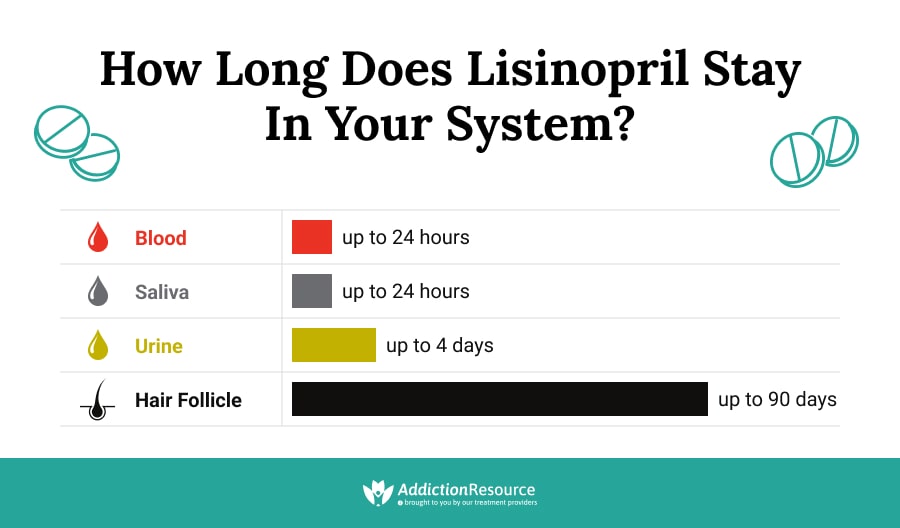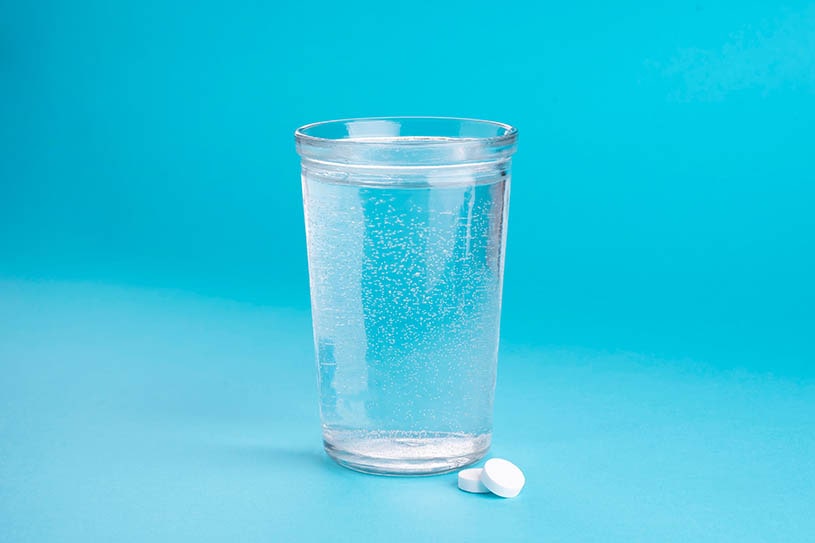Lisinopril (brand names – Prinivil, Zestril) is an Angiotensin-converting enzyme inhibitor (ACE inhibitor) class of medications commonly prescribed for hypertension and various heart disorders. The use of anti-hypertensive medication is vital for people with hypertension. It’s imperative for patients to know all the information about this drug before taking it. This includes an overview of its half-life, metabolism, excretion, and ability to show up on drug tests.
Table Of Contents:
Understanding how long lisinopril stays in the body ensures that the person knows what to expect. It also provides a better understanding of the appropriate timing of the doses. This article aims to provide a clearer answer to queries regarding the time it stays in the body and the duration it takes to work.
Lisinopril Half-Life
Lisinopril, an ACE inhibitor, is generally used to help reduce blood pressure in patients with hypertension. Patients are advised to be aware of all factors related to the drug before they use it. This gives the person a better understanding of what they should expect. Asking about the half-life of this medicine is one particularly significant factor that needs to be covered. This refers to the time it takes for half of the chemicals in the medicine to be expelled from the individual’s body. When asking how long does Lisinopril stay in your body, about half of the drug’s concentration will be out of the body within 12 hours after administration. To be more specific, the half-life of medicine is stated as 12.6 hours. This conclusion was made by a research study published in the American Journal of Medicine. At this time, half of the dosage will be out of the person’s body.
Lisinopril Mechanism Of Action
Lisinopril is a long-acting, angiotensin-converting enzyme inhibitor that is used for the treatment of high blood pressure and to reduce the symptoms of systolic heart failure. Understanding the lisinopril mechanism of action helps us get an answer to the question “how does lisinopril work”. According to research, when a patient suffers from high blood pressure, a substance called angiotensin II produced in the body narrows his arteries. The enzyme ACE (angiotensin-converting enzyme) produces this substance angiotensin II. ACE is also responsible for stimulating the release of the hormone aldosterone that increases blood pressure.
Lisinopril MOA inhibits the angiotensin-converting enzyme. This, in turn, inhibits the production of angiotensin II and aldosterone to lower blood pressure. It also works by dilating the arteries. This reduces the work the heart has to do to pump the blood throughout the body and increases the supply of oxygen to the heart. This helps in lowering the patient’s blood pressure.
In the case of Prinivil use in treating heart failure, it acts by increasing the supply of blood and oxygen to the heart and also dilating the blood vessels to reduce the pressure on the heart. The heart, which may be damaged and weakened due to a heart attack, is assisted in pumping blood in the body with the help of Zestril.
How Long Does It Take For Lisinopril To Work?
Prinivil starts to work within a few hours of taking it. The time to reach peak concentration in the system can vary from 6-8 hours. At this time, it would be the most effective at reducing blood pressure levels. Although there was a trend to a small delay in time taken to reach peak serum concentrations in acute myocardial infarction patients. Additionally, its effect is not apparent immediately. It may take two to four weeks for its effects to manifest. Patients are advised to follow the prescription and continue medication whether they feel its impact or not. Hence, a few weeks of treatment may be required to experience an optimal reduction in blood pressure.
Some people may experience the side effects of Prinivil when they start taking the drug. The absence of immediate effects and adverse effects following its use may result in patients discontinuing this medicine. However, a patient should continue taking it as prescribed by the doctor to keep their blood pressure under control and reduce the risk of heart failure.

Lisinopril Metabolism And Excretion
The metabolism of a drug affects the time it will remain active in the system. Various drugs are metabolized mainly by the liver, which leads to ease of excretion. However, lisinopril doesn’t undergo any metabolism by the liver and doesn’t bind to other serum proteins. Following oral administration, the drug is absorbed slowly, but is readily available without any biotransformation and isn’t affected by food, age, or co-administration with other medications. It is principally excreted unchanged via glomerular filtration in the urine by the Kidneys. Significant accumulation of this medicine occurs in patients with severe renal dysfunction. This data can also help a person better understand the possible Lisinopril adverse effects.
How Long Does Lisinopril Stay In Your System?
Lisinopril has an average half-life of 12 hours which means it takes almost 4-5 times more for the complete removal of this drug from a person’s blood. However, the time it takes for the chemical to leave the body differs between urine, hair, blood, and saliva samples.
How Long Does Lisinopril Stay In Urine?
When looking at what the Lisinopril half-life is, many people start by considering the time it takes the drug’s chemicals to be undetectable in the urine. In most cases, the drug remains detectable in urine for up to four days after the administration of the medicine. However, the results differ from person to person.
A well-hydrated person or person with highly acidic urine is more likely to test negative. On the contrary, a dehydrated person or person having alkaline urine is more likely to test positive for a longer duration.
How Long Does Lisinopril Stay In Hair?
The drug remains active in hair follicles for a longer time compared to other samples that may be used for testing. It is possible that the chemical found in the drug can be detected up to 90 days after the administration of the drug. There are also cases where the drug remains detectable for longer than 90 days. Although it isn’t common to test for this drug via hair samples and it doesn’t show exactly when you last took this drug, it can indicate the frequency of use. If this medicine has been used on a regular basis, that is usually detectable with these drug tests.
How Long Does Lisinopril Stay In Blood?
Zestril leaves the blood circulatory system rather quickly. In most people, the drug will not be detectable in a blood sample after 24 hours have passed since the last use of the medicine. However, it may be detectable in blood for about three days. The body takes about 12 hours to process and remove half a dosage of this medicine, and it goes through this process five to six times for the complete removal of this drug.
How Long Does Lisinopril Stay In Saliva?
Saliva tests are non-invasive and are easily available in public settings. Since lisinopril has no psychoactive effects, it is uncommon for it to be checked via saliva tests. However, the detection window for saliva is very similar to blood. The chemical will remain detectable in a patient’s saliva for an estimated 24 hours after the last dose was taken.

Factors Affecting Zestril Detection Window
When looking for the duration Zestril stays in the system, a person should note that there are a few factors that affect this calculation. First of all, this medicine is known for its poor bioavailability. Only 25-30% of orally administered this medicine is absorbed and made available for its pharmacological activity. Prinivil is the only ACE inhibitor that is not metabolized by the liver, like many other medicines used to treat hypertension. Hence, a long list of factors may affect the detection window of drugs like Zestril by various screening methods, which includes:
- Genetics: Genetics plays an important role in speeding up or slowing down the way of processing the drug.
- Age: The extremes of age, elderly and children, might test positive for the drug for a longer duration. As elderly people have difficulty processing the drug and children have difficulty eliminating the drug, it makes them prone to a positive drug test.
- Duration: Patients who have been taking this drug for a longer duration of time will test positive for a prolonged period and vice-versa.
- Frequency: Frequent users of this drug might find the level of this drug to be positive on lab tests for a longer time
- Dosage: The higher the dosage being administered, the longer the patient will test positive for this drug on various tests.
- Metabolism: The metabolism rate of a person affects the detection window of the medicine. People with a faster metabolism may find that the drug is expelled from their system faster.
- Weight: In overweight individuals, the amount of drug that remains in the fat cells might cause them to test positive for this drug for a longer time.
- Health condition: Certain medical conditions such as organ damage can increase the time it takes for the drug to leave the body. Kidney damage is the factor to be taken into concern here.
- Some other substances can also increase the time it takes for the drug to be excreted. While Lisinopril and potassium may not have such an interaction, using the drug with alcohol may cause a delay in excretion. Hence, the patient is advised to take all of these factors into consideration before taking the drug.
Will Lisinopril Show up In a Standard Pre-Employment Drug Test?
Researchers have now developed methods to detect blood pressure medications in different bodily samples. Although this medicine has a very low potential to be abused, it may however appear on drug tests if the employer has any reason to look for it. Whether it is to check if you’re following the prescription or to test if you’ve overdosed on it, Lisinopril remains detectable by modern drug tests for a varying length of time. However, Lisinopril is not tested for the 12-panel drug test which tests drugs like amphetamines, opiates, barbiturates, benzodiazepines, etc.
How To Detox From Prinivil Safely?
It may take some time for the body to completely rid itself of its effects. How long lisinopril stays in one’s system depends on its half-life. This period takes about 12 hours, which means that it will take about three days for the medicine to flush out of one’s system.
Since the mechanism of action of this medicine constitutes lowering the patient’s blood pressure on a long-term basis, patients are advised to continue the medicine as prescribed. If any of the side effects are bothersome, the patients can consult their doctor who might prescribe some alternative to Zestril.
In rare cases, Prinivil abuse can appear in some categories of patients. They should be monitored for the warning signs if they are taking high doses of this ACE inhibitor, or using it for prolonged periods. Substance abuse may lead to severe health harm, so it must be treated as soon as possible. Consult with a healthcare professional about rehabilitation options available if substance abuse occurred to a loved one. Medical detox is the initial step in addiction treatment. After completing this phase, a suitable inpatient or outpatient drug rehab program should be chosen for a successful recovery.

Frequently Asked Questions
Is Lisinopril a Beta-Blocker?
No, it is not a beta-blocker. It is an antihypertensive drug belonging to the ACE inhibitor class of medicine.
Is Lisinopril an Ace Inhibitor?
Yes, it is an oral long-acting Angiotensin-Converting Enzyme(ACE) inhibitor medicine.
What Does Lisinopril Do?
It is used to treat hypertension, various heart disorders, diabetic nephropathy and to help reduce the risk of future strokes and heart attacks.
Hope Without Commitment
Find the best treatment options. Call our free and confidential helpline
Most private insurances accepted
Page Sources
- Chase, S. L., & Sutton, J. D. (1989). Lisinopril: a new angiotensin-converting enzyme inhibitor. Pharmacotherapy, 9(3), 120–130. https://doi.org/10.1002/j.1875-9114.1989.tb04117.x
- Olvera Lopez E, Parmar M, Pendela VS, et al. Lisinopril. [Updated 2021 Jun 15]. In: StatPearls [Internet]. Treasure Island (FL): StatPearls Publishing; 2021 Jan-. Available from: https://www.ncbi.nlm.nih.gov/books/NBK482230/
- Beermann B. (1988). Pharmacokinetics of lisinopril. The American journal of medicine, 85(3B), 25–30. https://doi.org/10.1016/0002-9343(88)90346-4
- Zisaki, A., Miskovic, L., & Hatzimanikatis, V. (2015). Antihypertensive drugs metabolism: an update to pharmacokinetic profiles and computational approaches. Current pharmaceutical design, 21(6), 806–822. https://doi.org/10.2174/1381612820666141024151119
- Gomez, H. J., Cirillo, V. J., & Moncloa, F. (1987). The clinical pharmacology of lisinopril. Journal of cardiovascular pharmacology, 9 Suppl 3, S27–S34. https://doi.org/10.1097/00005344-198700003-00008
- Armayor, G. M., & Lopez, L. M. (1988). Lisinopril: a new angiotensin-converting enzyme inhibitor. Drug intelligence & clinical pharmacy, 22(5), 365–372. https://doi.org/10.1177/106002808802200501

 Authored by
Authored by  Reviewed by
Reviewed by 